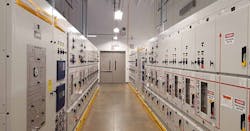This is the second entry in a four-part Data Center Frontier special report series that explores how Gallium Nitride, or GaN, is showing significant benefits for data center equipment refreshes. This article breaks down GaN technologies and benefits into four pillars normally used to vet power converter technologies to provide a comprehensive understanding of the potential of GaN power.
Download the full report.
Gallium nitride (GaN) is a wide bandgap semiconductor material that has been in use since the 1990s. GaN initially found its way into light emitting diodes (LED) as well as optoelectronics. GaN’s very high breakdown voltages, high electron mobility, and saturation velocity has also made it an ideal candidate for high-power applications.
In 2010, the first low-voltage GaN transistors hit the market. In 2012, the first high-voltage GaN FETs (field effect transistors) targeting 650 Volt (V) applications became available, which is where GaN gets interesting.
At this power level, GaN’s inherent attributes enable it to displace silicon in numerous AC to DC applications designed for server, automotive, broad industrial, computing, renewable energy and telecom. Adoption is gaining momentum in these markets as confidence in the technology’s reliability and performance rise.
Manufacturers of power supplies, servers and other power-driven equipment typically vet power converter technologies based on four key pillars. Viewing GaN in this light provides a fundamental understanding of the value proposition that GaNbased solutions can bring to data center applications.
Lifetime reliability tests determine the GaN solution’s intrinsic capabilities within extreme temperature and voltage environments.
Pillar One: Quality and reliability
Heavily-stressed power systems like those used in data center equipment and infrastructure must operate reliably. Power conversion technologies, therefore, must first and foremost exhibit high quality and high reliability. Will transistors fail under high-stress conditions? What is a transistor’s average life span? Will transistor performance degrade over time and, if so, how much? To determine answers to these and other questions, semiconductor leaders put devices through industry-standard qualification tests and, in the case of high-voltage GaN pioneer Transphorm, extended rigorous tests to assure product reliability.
JEDEC (general market) and AEC-Q101 (automotive market) are trusted industry qualifications testing a transistor’s infant mortality rate (device interactions between package mold compound materials, lead frames, die attachments).
Lifetime reliability tests determine the GaN solution’s intrinsic capabilities within extreme temperature and voltage environments. They involve accelerating normal life cycle factors to identify failure rates over time (e.g., FIT, MTBF and PPM rates).
Temperature cycles, power cycles, high-temperature gate bias, high-temperature direct current, high-voltage overstress, and high-temperature reverse bias (including destructive physical analysis), unbiased accelerated stress testing, wire bond integrity, and much more are all analyzed. Note: GaN exhibits different failure modes than silicon. And, as many of these tests were designed for silicon, select tests such as High-Temperature Direct Current, HighTemperature Over Stress, and Low/High-Temperature Reverse Bias are necessary to accurately determine GaN-specific lifetime reliability.
Certain GaN power transistors have successfully gone through all of the above discretionary tests, satisfying basic requirements for use in real-world applications, including earning JEDEC and AEC-Q101 qualifications. These transistors are designed and manufactured by Transphorm. The company’s quality and reliability data are publicly available as they build confidence in GaN as well as inspire application engineers to push the envelope with respect to system features and designs.
Pillar Two: Performance
Performance can be viewed in three segments: efficiency, density, and system cost.
GaN transistors convert energy to usable power at traditional frequencies, as they internally switch two to three times faster than silicon transistors. High switching speeds result in lower crossover losses; simply put, less energy is lost or wasted during conversion. Collectively, these advantages then result in higher power efficiency, increased power density with the same thermal footprint, and the ability to reduce size, creating a lighter weight, smaller overall system that can lead to still more benefits.
GaN can be used in various power system topologies. However, GaN uniquely enables power system engineers to use a hardswitching topology with a specific power factor correction technique (bridgeless totempole) that is, in most cases, impractical with silicon. This system configuration maximizes the GaN’s total potential (efficiency, power density and size) while lowering system component count, and, thereby the overall system cost.
Outside of the hard-switched bridgeless totempole PFC, GaN can also be used in soft-switching topologies. In these applications, GaN again offers lower crossover losses and reduced output capacitance, therefore having the ability to operate efficiently at lower load currents and be driven at higher frequencies than silicon to achieve performance increases.
This is all a cursory explanation as to how GaN-based power systems can dramatically increase power density over silicon-based power systems, generating more power output in the same-sized system or the same power output in a smaller-sized system. These are key capabilities desired, for example, by power supplies seeking greater than 80 PLUS Titanium efficiency levels.
On the topic of performance, specific on-resistance is a standard used to show MOSFET technology evolution. As seen in Figure 1, silicon MOSFETs have hit their theoretical limits. Related, though silicon carbide (SiC) — another high-voltage alternative material — is coming closer to its limits, GaN still has a way to go.
Pillar Three: Production
Though introduced in recent years, high-voltage GaN is in production and accessible. In fact, 6-inch wafers are produced in a number of fabs with manufacturing lines dedicated to GaN’s unique requirements.
What’s more, reputable power supply and industrial equipment manufacturers are in production — Bel Power, CORSAIR, Seasonic, Yaskawa — selling groundbreaking GaN-based products that literally demonstrate GaN’s ability to increase efficiency and power density. For example, Seasonic’s new high-efficiency 1.6 kW platform uses leading GaN technology. This platform yields a 99 percent PFC efficiency and will be deployed in Seasonic battery chargers as well as catalog Seasonic PC, server and gaming power supplies. Additional use cases will be outlined in a later section.
Pillar Four: Cost and technology evolution
Leaders in the power space have been researching and developing high-voltage GaN for a decade or more. In fact, the GaN technology specifically referenced as examples in this paper is third generation. High-voltage GaN suppliers have published real-world use cases based on customer products available in the market. (Consider this: When going through a data center refresh cycle, you don’t have to work with ”up-and-coming” solutions that may or may not stand the test of time.)
The generational improvements have not only increased performance, quality and reliability highlighted above, they have also enabled transistor price reductions year over year. This is an important outcome as it demonstrates that high-voltage GaN innovation and volume increases will drive down cost. This bodes well for the technology’s overall ROI factor and market longevity.
This Data Center Frontier series focused on data center efficiency and GaN technologies will also cover the following topics over the coming weeks:
- Rise of GaN Technologies Bodes Well for Data Center Efficiency
- Decrease OPEX using GaN
- High Voltage GaN Cases
- Leveraging GaN: How to Get Started
Download the full Data Center Frontier Special Report, “Optimizing Data Center Power Efficiency: How Forefront GaN Technologies Show Significant Benefits for Data Center Refreshes,” courtesy of transphorm.
And for further coverage, check out Data Center Frontier’s page dedicated to the GaN market that will provide the latest stats and info on the power conversion tool that has the potential to change the landscape of the modern data center.
About the Author



